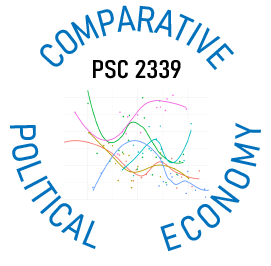Lecture 13.1
The Populist Backlash in the West
Emmanuel Teitelbaum
The Origins of Populism
What is Populism?
- A political movement that champions the people against the establishment
- Left-wing populism: dyadic and vertical, mobilized along class lines
- Government/elites have forgotten about the ordinary people
- “Ordinary people” could be the middle class or the poor, depending on the country or region
- Right-wing populism: triadic and horizontal, mobilized along class and ethnic lines
- Government/elites have forgotten about the ordinary people in the racial or ethnic majority
- Attacks establishment for siphoning resources to immigrants and minorities
- Crucially, populists operate inside of a democratic system
- As opposed to fascists or left-wing extremists in Europe or Latin America
Where Does Populism Come From?
- Reaction to changes in the economy (and immigration)
- Often spurred by laissez-faire economic policies that benefit the rich
- Frequently the long-term result of economic crisis (1870s-1880s, 1929, late-1970s, 2008, etc.)
- Populists accuse mainstream parties of ignoring crisis altogether, not addressing the root causes of the crisis, or selling out ordinary voters in order to resolve crisis
Where Does Populism Come From?
- Most left-wing populist movements demand government intervention that will reduce inequality and restore the middle class
- But populist demands can be coupled with demands to get the government out of the economy
- Usually a component of right-wing populist groups
- The government “distorts” the economy by taxing wealth and giving it to poor minorities
- Or to middle class bureaucrats
Neoliberal Policy in the U.S.
- Birthplace of neoliberalism
- Home of “Washington Consensus”
- Reaction to competitive challenges faced by U.S. business starting in the 1970s
- Factories in Western Europe and Japan
- Steel production throughout Asia
- Textile production in developing countries
Neoliberal Policy in the U.S.
- Business felt regulations and unions prevented them from competing
- Repressed unions
- Moved factories abroad and to “right to work” states
- Hired more immigrant workers
- 1965 Immigration and Naturalization Act (Hart-Celler)
- From quota-based to family and skill-based immigration
- Pushed for free trade agreements like NAFTA
- Problem was that immigration and trade were not popular with most voters
Populism in the United States
Populism in the U.S. I
- People’s Party in the U.S. (1890s)
- Formed by members of Kansas Farmers’ Alliance and Knights of Labor
- Reaction to Grover Cleveland and “robber baron” capitalism of 19th century
- Grew out of farm revolt of 1870s and 1880s
- Steep fall in agricultural prices
- Aggravated by increased transportation costs
- Railroad monopolies
Populism in the U.S. I
- Saw themselves as representing people vs. elites
- People = farmers and workers
- Elites = capitalists, speculators and mainstream parties
- Won lots of seats in 1894 but was coopted by mainstream parties in subsequent years
Populism in the U.S. II
- Huey Long
- Governor of Louisiana (1928-1932); U.S. Senator (1932-35)
- Railed against power and influence of oil companies
- “Share Our Wealth Society”
- Proposed wealth cap ($5 million per family; $1 million per individual)
- Use revenue to fund guaranteed income
- Forced Roosevelt to pass “Second New Deal” that included social security, NLRA, WPA and wealth taxes
Populism in the U.S. II
- George Wallace
- Governor of Alabama (four terms)
- Government “full of rich people” who wanted to give their money to the poor
- Led conservative backlash to Civil Rights Act, Voting Rights Act and racial integration
- Framed opposition to integration as defense against “big government”
Populism in the U.S. III
- Reaction to rise of neoliberalism
- Ross Perot
- Attacked trade deals and distortion of politics by big business
- Ross Perot’s Giant Sucking Sound
- Pat Buchanan
- Also attacked trade deals, but also immigration
Populism in the U.S. III
- Tea Party
- Attacked Obama’s mortgage bailouts, Obamacare and illegal immigration
- Occupy Wall Street
- Attacked Obama for not being tough enough on bankers, focused on inequality
- The Occupy Movement
Populism in the U.S. Today
Trump vs. Sanders
- Trump
- Prior to running in 2016, he was a moderate on social issues (like abortion) and social spending (supported idea of universal health care)
- Always opposed free trade and immigration
- Sanders
- Main target is the “billionaire class” (the 1%)
- Advocates Nordic-style social democracy as an antidote to rising inequality
Discussion
- Was Trump’s support more due to a reaction to neolibarlism or to immigration?
- Why was Bernie Sanders, who focused on inequality and the one percent, ultimately less successful than Trump as a presidential candidate?
- In your discussion, reference the chapter you read from Judis’s The Populist Explosion
